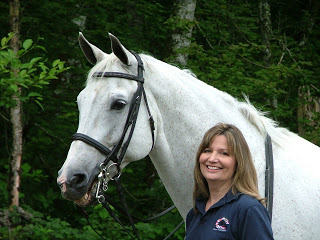How many times do I have to tell you to feed the dog?
I'm delighted to welcome author Susan Schreyer today as a guest blogger! Susan lives in Monroe, Washington with her husband, two teenage children, an untrustworthy rabbit and a demanding old cat. Her horse lives within easy driving distance. When not working diligently writing her blogs "Writing Horses" and "Things I Learned From My Horse," articles for worthy publications, or about people in the next town being murdered, Susan trains horses and teaches people how to ride them. She serves on the steering committee of the Guppies Chapter of Sisters in Crime and is co-president of the Puget Sound Chapter of SinC. Death By A Dark Horse, is Susan's debut mystery and the first of a series. Her website is http://www.susanschreyer.com/
 In the conceiving of a new story, the creation of unique characters can be difficult. We don't want them to be just like all the others, but with different names, so we build complex biographies. We explore the family trees and significant events in their time that shape each character and the way they respond to the world around them. It's all good, and all useful. Occasionally, a character will spring fully formed into our minds. We see them, hear them speak, feel we know them like a brother or sister. Lucky us! Or is it really lucky? We may know them well, but how are we going to bring that knowledge to the reader? We still face the same struggle we had with characters we had to build from the ground up.
In the conceiving of a new story, the creation of unique characters can be difficult. We don't want them to be just like all the others, but with different names, so we build complex biographies. We explore the family trees and significant events in their time that shape each character and the way they respond to the world around them. It's all good, and all useful. Occasionally, a character will spring fully formed into our minds. We see them, hear them speak, feel we know them like a brother or sister. Lucky us! Or is it really lucky? We may know them well, but how are we going to bring that knowledge to the reader? We still face the same struggle we had with characters we had to build from the ground up.
We try to avoid a laundry list of personality traits in much the same way we try to avoid a laundry list of physical traits. For example, if a character is overweight we can show his size by making him unable to squeeze through a small restroom window and escape his pursuers. That solution is pretty easy, and obvious. And it's fun for a writer. More complex and frustrating is how to communicate the nuances of character and emotion.
We can show the character's body language, and write dialog between that character and another. We can show how he responds under pressure. We can have other characters talk about him. All of these tried and true methods have potential for conflict -- and conflict is excellent for driving the reader to turn the page.
Yay!
But…can't we add more depth, be more subtle, do something else to pull the reader into the story and build understanding of our character?
Of course. Add a pet.

We can explain much about a character by showing his interactions with animals -- and without screaming the information at the reader. This is one of my favorite tools. People can act very differently around animals than humans. Much pretense is dropped and we catch glimpses of their psychology that would normally be hidden in human interaction. Animals also respond differently to individuals. What's more, the writer can use a character's relationship with an animal to mirror and add a depth of understanding to another plot line. There's a lot of creative potential in this approach.
So, consider getting your character a pet. And instead of using it as live furniture, exploit the opportunities they can provide. Your readers may thank you for it.
What are some of your favorite character-revealing moments involving animals?
 In the conceiving of a new story, the creation of unique characters can be difficult. We don't want them to be just like all the others, but with different names, so we build complex biographies. We explore the family trees and significant events in their time that shape each character and the way they respond to the world around them. It's all good, and all useful. Occasionally, a character will spring fully formed into our minds. We see them, hear them speak, feel we know them like a brother or sister. Lucky us! Or is it really lucky? We may know them well, but how are we going to bring that knowledge to the reader? We still face the same struggle we had with characters we had to build from the ground up.
In the conceiving of a new story, the creation of unique characters can be difficult. We don't want them to be just like all the others, but with different names, so we build complex biographies. We explore the family trees and significant events in their time that shape each character and the way they respond to the world around them. It's all good, and all useful. Occasionally, a character will spring fully formed into our minds. We see them, hear them speak, feel we know them like a brother or sister. Lucky us! Or is it really lucky? We may know them well, but how are we going to bring that knowledge to the reader? We still face the same struggle we had with characters we had to build from the ground up.We try to avoid a laundry list of personality traits in much the same way we try to avoid a laundry list of physical traits. For example, if a character is overweight we can show his size by making him unable to squeeze through a small restroom window and escape his pursuers. That solution is pretty easy, and obvious. And it's fun for a writer. More complex and frustrating is how to communicate the nuances of character and emotion.
We can show the character's body language, and write dialog between that character and another. We can show how he responds under pressure. We can have other characters talk about him. All of these tried and true methods have potential for conflict -- and conflict is excellent for driving the reader to turn the page.
Yay!
But…can't we add more depth, be more subtle, do something else to pull the reader into the story and build understanding of our character?
Of course. Add a pet.

We can explain much about a character by showing his interactions with animals -- and without screaming the information at the reader. This is one of my favorite tools. People can act very differently around animals than humans. Much pretense is dropped and we catch glimpses of their psychology that would normally be hidden in human interaction. Animals also respond differently to individuals. What's more, the writer can use a character's relationship with an animal to mirror and add a depth of understanding to another plot line. There's a lot of creative potential in this approach.
So, consider getting your character a pet. And instead of using it as live furniture, exploit the opportunities they can provide. Your readers may thank you for it.
What are some of your favorite character-revealing moments involving animals?
Published on January 21, 2011 08:07
No comments have been added yet.



